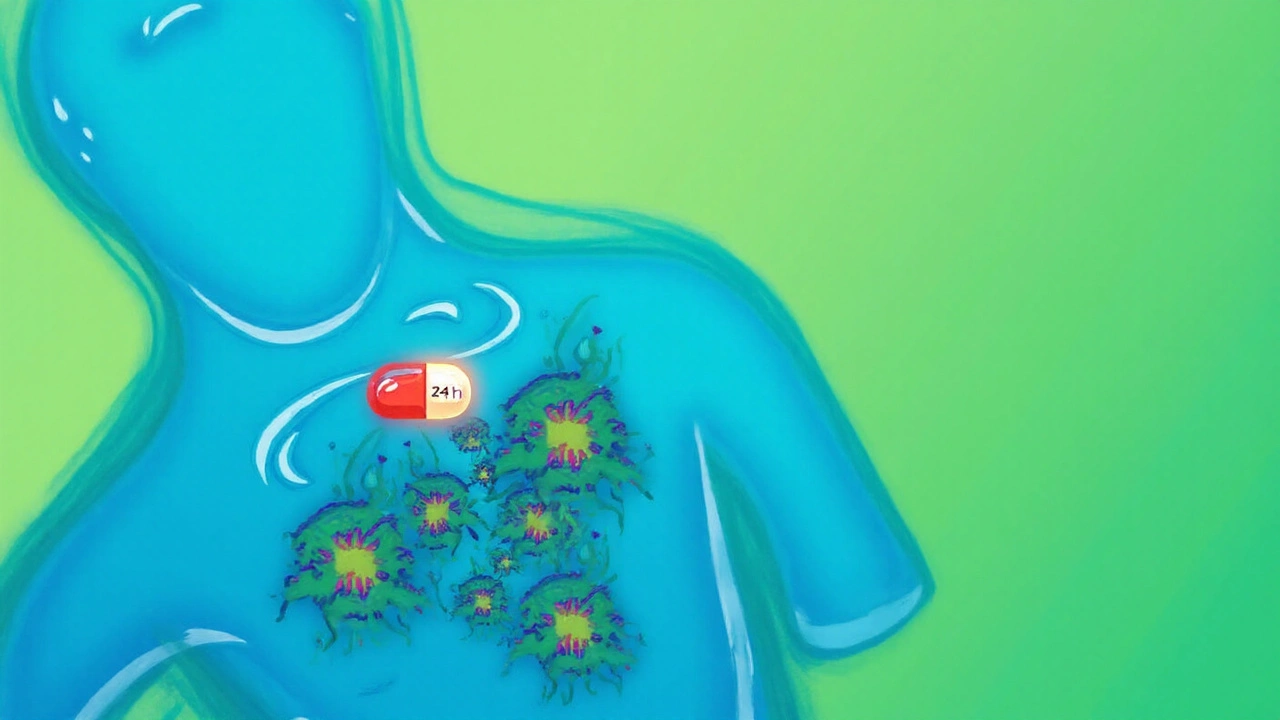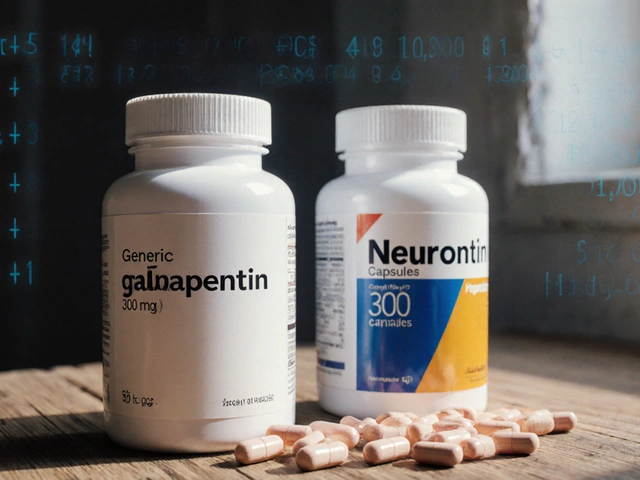Antibiotics that need you to remember them several times a day? Honestly, I’d forget—between feeding my cat Osiris and running late for yet another Bristol bus, who wouldn’t? Secnidazole, though, only needs one proper shot. Sounds almost too easy, right? This medicine grabs attention partly because it makes life easier for anyone dreading a complicated pill schedule. But what’s so special about it? Strap in; we’re about to zero in on how secnidazole is quietly changing the game for certain bacterial infections.
What is Secnidazole and How Does It Work?
Secnidazole is an antibiotic, part of a group of medications called nitroimidazoles. It’s like a close cousin to metronidazole, but with its own twist. What makes it stand out is its super long half-life, meaning it stays active in your body for a nice long while after you take it. That makes it perfect for single-dose treatments—especially appealing if you’ve ever forgotten a dose of antibiotics and had to sheepishly admit it at a follow-up appointment. In the UK and many countries, secnidazole is mostly used to treat infections caused by certain parasites and anaerobic bacteria. It’s especially useful for infections such as bacterial vaginosis, trichomoniasis (a common sexually transmitted infection), and some types of intestinal and dental infections.
Here’s how it does its job: When secnidazole enters the scenes inside your body, it targets the DNA of bacteria or parasites, messing up their ability to grow and multiply. If you’re a science buff (or just nosy like me), you’ll appreciate that it’s the unique nitro group on the molecule that lets secnidazole sneak into the cells, get reduced (that’s a chemical process), and release free radicals that wreck the DNA of the invaders. The bacteria or parasites can’t recover from that kind of sabotage, so your body can clear out the infection much faster. Another thing to love is that secnidazole’s chemical structure means it can be taken with or without food, and you don’t have to worry about squeezing it into a specific mealtime window.
Here’s a fact more people should know: Secnidazole got the nod for treating bacterial vaginosis in single, oral dose form in both the US (FDA, 2017) and in parts of Europe, which speaks to its global credibility. It’s not just for vaginal infections; in some places, secnidazole shows up as an off-label helper for severe dental abscesses, amoebiasis, and giardiasis (the last two are parasites causing gross tummy troubles). If you’re curious about how long a single dose sticks around, most sources say its half-life is around 17–29 hours. To put it differently, it keeps working inside you for more than a full day compared to other antibiotics that bid you adieu after a handful of hours.
Secnidazole comes in the form of granules or tablets. One big draw: you don’t have to swallow a mountain of pills—you’ll often just mix the granules with something soft (like applesauce or yogurt), eat it, and you’re set. I know people who nearly faint at the thought of swallowing pills, so this is a massive win.
Reasons People Get Prescribed Secnidazole
The number one reason—especially in adults assigned female at birth—is bacterial vaginosis. It’s more common than most will admit, and the symptoms (like weird discharge and odor) are an instant killjoy. Secnidazole wipes out the bacteria behind BV in most people with a single 2-gram dose. That’s just two grams mixed once with food; no awkward pill calendar slapped on your fridge. Next up is trichomoniasis. This is a sexually transmitted infection caused by a parasite, and it’s dead easy to catch (if we’re being real) and sometimes doesn’t show symptoms. Both partners are usually treated at the same time—otherwise, it’s just a game of ping-pong with symptoms coming right back.
The other use is for protozoan infections, like giardiasis or amoebiasis, usually picked up from contaminated water or food when traveling. These can make your holiday memorable for all the wrong reasons (think aggressive tummy cramps and never being far from a loo). Some doctors use secnidazole when they want a quick, straightforward solution. Though it’s not officially approved for dental abscesses yet everywhere, some dentists use it off-label because of its effectiveness and you don’t have to keep knocking back antibiotics for days.
Interesting fact: Secnidazole isn’t given to children under 2. Pregnant women are also usually told to avoid it unless there’s a pretty strong reason, mostly because there aren’t enough good studies yet to know if it’s totally safe during pregnancy.
Let’s make this clearer with a quick look at its main licensed uses and recommended dosages:
| Condition | Usual Dose | Route | Notes |
|---|---|---|---|
| Bacterial Vaginosis (Adults) | 2g once | Oral (granules/tablet, mixed with soft food) | Just one dose needed |
| Trichomoniasis | 2g once | Oral | Both partners should be treated |
| Giardiasis/Amoebiasis | 1-2g once (adults) | Oral | Varies by location/protocol |
Getting a doctor to prescribe secnidazole depends on where you live and if it’s considered the first-line treatment. It’s only available with a prescription, so there’s no popping down to the chemist and picking it up alongside your paracetamol. And don’t even think about using leftovers; once it’s been mixed, it needs to be taken right away.

Side Effects and Safety: What Should You Expect?
No medicine is perfect, right? I once broke out in a rash from a totally random antibiotic, so it’s only fair to talk straight about potential side effects. Secnidazole is usually easy on most people, but here’s what you might expect: mild tummy aches, metallic taste in the mouth, sometimes headaches, and once in a blue moon, nausea. Most people find any symptoms settle after a day or so. The most annoying bit is probably the metallic taste that hangs around for a few hours; it’s as if you’ve been licking a coin (I wish I were exaggerating). Eating or drinking something with a strong flavor—a squeeze of lemon in water or even strong black tea (if you’re in the UK club)—can help mask that odd taste.
A rare but real reaction is an allergy. Any signs of facial swelling, rash, or trouble breathing? Stop and get help immediately. Don’t brush it off or wait for things to "calm down." Serious reactions are pretty rare, but don’t ignore them. Other rare issues might be dizziness, and if you have a history of seizures, best let your GP know. If you’re dealing with liver problems, give your prescriber the full scoop so they can adjust your dose or pick something else if needed.
Now, a golden rule—don’t mix secnidazole with alcohol, even though some studies say the old "antibiotics plus booze" problem is mainly with metronidazole. It’s just not worth risking the headache, queasiness, or unpredictable effects. Wait at least 3 days after taking it before pouring yourself a glass.
| Common Side Effects | Uncommon/Rare Side Effects |
|---|---|
| Metallic taste | Allergic reactions (rash, swelling) |
| Mild stomach pain | Dizziness |
| Nausea | Seizures (very rare) |
| Headache | Liver issues (in people with pre-existing conditions) |
There are those who ask, "Can secnidazole mess with my other medications?" Short answer: yes, sometimes. It can interact with drugs that affect liver enzymes, anticoagulants (blood thinners), and a few others. Best bet is to hand your pharmacist or GP a full list of everything you take—from prescription meds to herbal teas your aunt swears by.
Breastfeeding? Some guidelines suggest temporarily pausing for at least 4 days (that’s how long the drug might stick around in your milk at a meaningful level). This is because the effects on tiny babies aren’t well studied. Plan ahead with expressed milk or formula on hand, just in case.
Tips for Taking Secnidazole: Making it Work for You
Since you only have to take Secnidazole once for most infections, sticking to the instructions is everything. It’s not your everyday pill experience. The granules mix easily into foods with a thick, soft texture—applesauce, yogurt, or pudding are go-tos. Skip hot drinks; the heat can mess with the granules. And don’t try to mix it into water or juice—it won’t dissolve properly, and you’ll be left with gritty clumps at the bottom.
- Eat the entire mixture at once. Don’t split it up or nibble it over several hours. That dose needs to land all at once to work correctly.
- If you miss your dose window (the time your doctor told you), take it as soon as you remember. Past 12 hours? Ring your GP for advice. Don’t double-up just to make up for it.
- Feel a bit queasy? Take it right after eating, not before meals. That works for most people, and the side effects are tamer.
- Don’t use secnidazole to treat anything unless your doctor says it’s the right time and diagnosis. The single-dose magic doesn’t mean you can use it for every sore throat or cough.
Store the medicine out of sight and reach of children and pets—my Osiris once tried to bat at a stray pill, and I definitely don’t need a cat on antibiotics. Granules should stay dry and in their original packaging until you need to mix them.
If you’re treating a sexually transmitted infection like trichomoniasis, let your recent partners know so they can get checked and treated as needed. Otherwise, the infection might stick around or boomerang back to you. For things like bacterial vaginosis, keep in mind that even single-dose treatment doesn’t stop it from coming back someday—it’s about clearing it for now, but there’s no magic forever fix.
If you’re going on a trip to places where tummy bugs are a risk, talk to your GP about travel kits, but never dumpster-dive into your old antibiotics drawer. Each infection needs its proper match.
After your dose, listen to your body. Most symptoms improve within a few days. If they don’t, or you suddenly feel worse, give your doctor a heads up. Don’t share your leftover medicine or take someone else’s. Want to speed recovery? Rest, stay hydrated, and go easy on your gut for a day or two. Avoid heavy meals or alcohol during that time, and your recovery will likely breeze by.






Tiffany Owen-Ray
Great write-up — thanks for making secnidazole feel less like scary pharmacology and more like a practical, usable tool.
I really appreciate the patience in explaining why a single 2g dose can be preferable: not just convenience, but adherence, fewer opportunities for resistance to select, and less disruption to someone's day — all real positives that get overlooked when people only focus on "which pill" rather than "how will this fit into a person’s life."
Also, the bit about mixing granules into applesauce or yogurt is life-changing for people who dread pills; practical tips like that reduce real barriers to treatment.
One more thought — when you mention the half-life and how it sticks around, that's not just a pharmacology flex: it changes counseling. You can tell people, honestly, that one properly taken dose gives meaningful drug exposure over a day, which is reassuring when someone’s terrified they'll forget a two-week course.
On the safety side, your caution about pregnancy and breastfeeding is well placed; in my experience, clinicians and patients alike underestimate how much uncertainty around reproductive safety steers decision-making, so calling that out helps people have better conversations with their prescribers.
I also liked the plain-speech warning about alcohol even if the mechanism is murky — it prevents the stereotypical late-night text asking whether a celebratory drink is “okay.”
Couple of quick practical suggestions: mention that people with neuropathy or those on enzyme-affecting meds should be extra explicit when they hand over their medication list, and highlight that labs might be appropriate if someone has abnormal baseline liver function.
Finally, a social note — for STIs like trichomoniasis your reminder that partners should be treated simultaneously is huge; the medical advice is only as good as the social follow-through, and many folks need practical tips on how to have that conversation or where to get partner treatment.
Anyway, nice balance of science, myth-busting, and everyday tips. This kind of article makes it easier to have calm, informed chats with clinicians, and that’s ultimately what helps people actually get better.
Thanks again for laying it out so accessibly.
Jill Brock
Single-dose wonder drugs sound amazing until you realize one dose doesn't fix poor sexual health education.
Sophia Simone
Point taken, but let's not romanticize a single-dose regimen as a panacea without scrutinizing population-level data.
From an evidence perspective, the endorsement of secnidazole for BV and trichomoniasis is conditional on context — prevalence, resistance patterns, and patient comorbidities all alter the risk-benefit calculus.
For instance, in areas with high rates of recurrent BV, single-dose therapy might offer a temporary fix but not address underlying microbiome perturbations that predispose to recurrence.
Moreover, the references to off-label dental uses should be framed more cautiously; anecdotal practice patterns do not substitute for randomized trials demonstrating safety and efficacy in odontogenic infections.
Finally, telling patients to "just wait three days before drinking" is facile without explaining the pharmacodynamics that motivate such an interval; otherwise it becomes an empty rule that people either follow blindly or ignore.
I recommend a bit more nuance in the risk communication and clearer signposting to guidelines by region.
AJIT SHARMA
This reads like an ad. Drugs that "stick around" are fine but we give it to too many people without fixing causes.
Neber Laura
not an ad just facts. people need clear choices
Karen Nirupa
Lovely, informative article — thank you for centering practical tips alongside the science.
I work with folks who travel frequently and with parents who juggle childcare, and the single-dose option often removes a barrier to care that isn't talked about enough: logistics.
That said, please encourage readers to discuss breastfeeding plans with their prescribers and to arrange for expressed milk if needed; it's not merely a clinical decision, it's a family planning one.
Also, culturally sensitive partner notification resources can make a world of difference when dealing with STIs — simple scripts and local clinic info help people do the right thing without shame.
Overall, a compassionate and clear piece that respects readers' intelligence while giving them usable next steps.
Quinn Comprosky
Nice breakdown. A couple of extra pointers from the trenches:
First, if someone has a history of migraines or a metallic taste that triggers nausea, suggest they take the dose with a small snack they know won’t upset their stomach — plain yogurt or applesauce works well.
Second, for those worried about interactions: make sure any OTC supplements get mentioned. Things like St. John's wort or certain herbal remedies can be overlooked and matter more than people think.
Third, if symptoms persist after a week, go back — don’t assume the single dose failed; it could be reinfection, mixed infection, or something else entirely.
Lastly, storing granules properly is surprisingly important; humidity can clump them, which makes mixing difficult and less palatable.
Hope that helps someone manage the practical side of this treatment.
Thomas Ruzzano
Looks handy but I’m skeptical of single-dose antibiotics becoming the new norm — sounds convenient for sure, but convenient for pharma too.
Make sure folks demand follow-up and not just a quick script.
Dan Tenaguillo Gil
I understand the suspicion, but let’s break this down without the conspiracy lens.
Single-dose therapies like secnidazole are chosen for specific microbiological and pharmacokinetic reasons: the long half-life means therapeutic concentrations persist long enough to eradicate susceptible anaerobes or protozoa.
That pharmacology is not primarily a marketing strategy — it’s an attempt to match drug exposure to organism biology, which can reduce the risk of missed doses leading to subtherapeutic exposure and selection for resistance.
Of course, stewardship remains crucial. Use should be guided by diagnostic certainty when possible, and clinicians should document indications and counsel patients about signs of treatment failure.
For communities with high rates of recurrent infection, combining medical treatment with behavioural and structural interventions (hygiene counseling, partner treatment access, safe water supply, etc.) is the responsible route.
So yes, scrutinize commercialization, but also recognize there are legitimate clinical reasons behind single-dose regimens that can benefit individual patients when used appropriately.
Ellie Chung
Honestly I want to know what that metallic taste tastes like with lemon — a weird curiosity.
If anyone tried mixing with fruity yogurt, spill the tea — did it mask the taste or make it worse?
Jill Brock
Masking the metallic taste is doable with strong flavors but don’t make it a habit to mix meds into heavy dairy without checking — some formulations can interact oddly.
Also, if someone’s getting recurrent BV, stop blaming single doses and look at other drivers like smoking, douching, or unprotected sex with new partners.